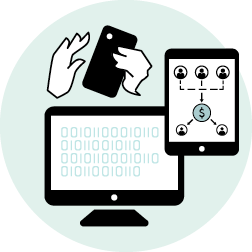Shopping cart abandonment: as online consumers, we’ve all done it for a variety of reasons. Browsing, adding items to a cart, and then failing to buy is ubiquitous. But as a business owner or manager, did you ever take the time to figure out how much it is costing your business?
According to the Baymard Institute, the latest statistics show that between 57% and 84% of shopping carts are abandoned before a customer makes a purchase. Statistics vary by industry, by geography, and by any given study.
But no matter which way you slice it, sellers are losing a big piece of the potential revenue pie when customers fail to finalize their shopping carts – billions and even trillions, by some calculations. For the average merchant, that can translate into hundreds of thousands in sales lost – often to competitors.
The reasons for cart abandonment aren’t always under a merchant’s control. Many people browse for fun or comparison shopping, for example. But abandoned carts indicate, at least in part, an ineffective or poor user experience for customers. Optimizing that experience can significantly reduce your cart abandonment rate and boost your online sales. Following are five ways website design and technology can help.
1. Make checkout as easy as possible
In general, users don’t like to spend too much time on the checkout process. They will abandon a cart if checking out is too complicated or time-consuming. The more work you force your prospective customers to do, the less likely they are to convert.
The principles of web navigation that apply to the rest of your site also apply to your checkout. Make it effortless for customers to save – and later return to – their carts, and help them navigate your site by offering logical, intuitive navigation options between your checkout and product pages.
Second, simplify your checkout forms. Forms spread over multiple pages, no checkbox to select the same billing and shipping address, or ambiguous form fields can make checkout time-consuming and complicated.
Third, make sure your checkout process and payment pages are optimized for mobile devices. Mobile shopping cart abandonment rates are at the top end of the range, and ecommerce brands lose $18 billion in sales as a result, according to one source. On the other hand, checkout optimization can increase conversions by 36%.
In addition to ease of navigation, mobile pages should include readable text and should not require a shopper to zoom in. The links should be far enough apart so they’re clickable. Content should adjust so users don’t have to rotate their screens.
2. Optimize page load times
According to Visual Website Optimizer, ecommerce shopping cart conversion rates drop 7% for every 1 second delay in page loading, costing billions in sales. Checkout pages that are slow to load practically beg impatient shoppers to take their business elsewhere, so optimize your checkout pages to be as fast as possible.
Some on-page technical elements are more easily optimized than others. For example, your images should be sized to maintain the crucial balance of quality and speed. You also can limit the use of ad network trackers, poorly implemented tags, and social plugins to improve page load times.
3. Offer multiple payment options
When it comes to paying for goods and services, more options are available than ever. One study found that offering multiple ways to pay helps businesses increase their revenue by nearly 30%. Those that accept 4 or more payment options bring in 7 times more annual revenue than those offering fewer options. Providing more payment choices minimizes – or eliminates – another frequent reason for customers to abandon carts or leave a payment page without completing the transaction.
Payment by ACH, which is especially appealing to businesses trying to break their dependency on paying by check, is increasingly utilized by businesses in the B2B space. In 2020, B2B use of ACH for vendor and supply chain payments rose almost 15%, to 1.2 billion transactions. Accelerated use of ACH among businesses continued a shift that started two years ago, when for the first time fewer than half of B2B payments were made by check, a study by the Association for Financial Professionals found.
4. Build trust with your buyers
When customers fill out forms to complete transactions, they’re trusting your organization with their personal information, including credit card or bank account details. But given the well-publicized data breaches of recent years, some are understandably hesitant to provide such sensitive data, and you may lose sales as a result. Trust signals can help.
Showcasing a valid SSL certificate and well-known and recognizable security badges (such as Norton and McAfee) can reassure customers about the trustworthiness of your store and security of their purchases.
So can hosted payments. Hosted payment pages include forms branded with the look of the seller’s business, so customers know they’re paying the right organization. Abandonment of the payment process can be minimized with a streamlined, familiar checkout process.
5. Use targeted email campaigns to recover lost carts
If your ecommerce platform includes a sign-in or somehow captures your customers’ email addresses, email can be an effective way to encourage shoppers to complete purchases. Recovery emails have much higher open and click rates than other types; according to one email automation provider, receivers open them 45% of the time, 21% click through, and 50% of those who click end up completing their purchases.
Standard email practices apply to creating recovery emails: an engaging subject line, appealing imagery, great copy, and a clear call-to-action (CTA). You also can improve response with segmentation of your triggered emails; for example, tee up three unique email messages depending on where visitors abandon your website or app (the product page, shopping cart, or checkout page). Tailor your message accordingly to deliver content and CTAs that are meaningful and compelling to the customer.
Finally, you need to determine the frequency and timing of cart recovery emails. Too early, and purchasers will ignore your emails; too late, and they will lose interest or may already have bought elsewhere. As with other marketing emails, testing and measuring will help you find the ideal timing for your customers and business.
A Little Self-Examination Can Go a Long Way
If you already have a reasonably well-designed and functioning website, tweaking pages and mobile apps doesn’t have to be complicated, time-consuming, or require a great monetary investment on your part. Given the benefits, taking the time to consider enhancements and refinements to your website may well be worth it.
If your shopping cart abandonment rates are too high for comfort, take a hard look at how customers experience your checkout and recovery processes. A little self-examination can go a long way toward improving that experience – and your revenues.



